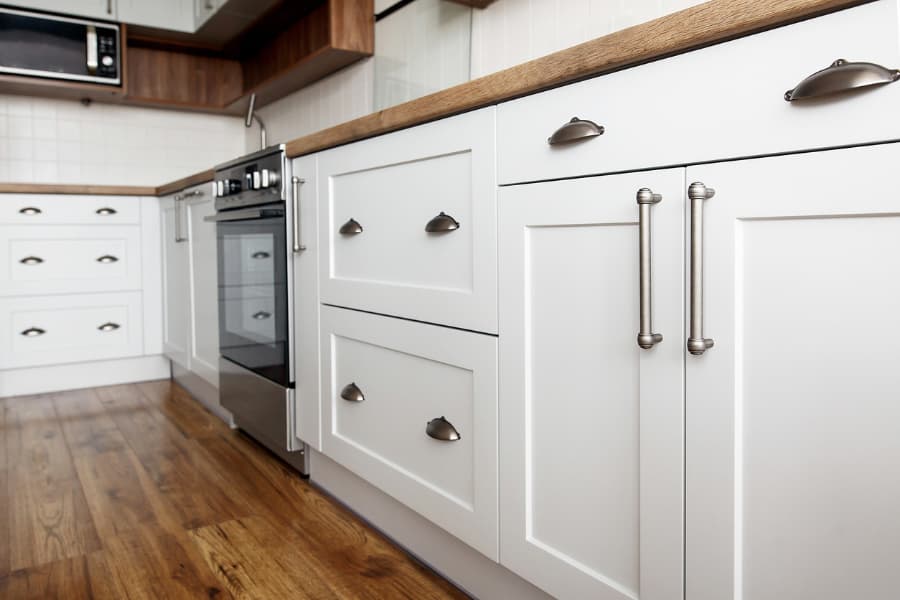When it comes to designing your dream kitchen, one of the most crucial decisions you’ll make is choosing the right cabinetry. Your cabinets not only play a functional role in storage but also have a significant impact on the overall aesthetics of your kitchen. In this blog, we’ll explore two primary options: custom cabinetry and stock cabinets. We’ll delve into the pros and cons of each to help you determine which is the best fit for your kitchen remodeling project.
Stock Cabinets: Convenience Meets Affordability
Stock cabinets, often referred to as off-the-shelf cabinets, are pre-manufactured in standard sizes and configurations. They are readily available in many home improvement stores and can be delivered quickly. Here are some of the advantages and disadvantages of opting for stock cabinets:
Pros:
- Affordability: Stock cabinets are generally more budget-friendly than custom options. If you’re working with a tight budget, they can be an excellent choice to get your kitchen renovation started
- Quick Delivery: Since these cabinets are mass-produced and readily available, you won’t have to wait for a long lead time. This is ideal if you want to complete your kitchen project promptly.
- Variety: You’ll find a wide range of styles, finishes, and colors to choose from, making it easier to find something that suits your taste.
Cons:
- Limited Customization: Stock cabinets come in predetermined sizes and configurations. If your kitchen layout is unique or you have specific storage needs, you may find it challenging to fit stock cabinets perfectly.
- Quality Varies: Quality can vary between manufacturers. Some stock cabinets may be made from lower-grade materials, which may not withstand the test of time.
- Limited Design Options: If you’re looking for unique design elements or specific features, stock cabinets might not provide the level of customization you desire.
Custom Cabinetry: Tailored Perfection
Custom cabinetry, as the name suggests, is built to your exact specifications. This option offers the ultimate in personalization and quality. Here are the advantages and disadvantages of choosing custom cabinetry:
Pros:
- Perfect Fit: Custom cabinets are designed to fit your kitchen’s unique layout, ensuring that every nook and cranny is utilized efficiently. This is especially beneficial for kitchens with irregular shapes or limited space.
- Endless Customization: With custom cabinetry, you have complete control over the materials, finishes, styles, and features. If you have a specific vision for your kitchen, custom cabinets can bring it to life.
- Superior Quality: Custom cabinets are typically crafted with high-quality materials and exceptional craftsmanship. This ensures durability and longevity, making them a wise long-term investment.
Cons:
- Higher Cost: The biggest drawback of custom cabinetry is the price tag. They tend to be significantly more expensive than stock cabinets due to the personalized design and craftsmanship.
- Longer Lead Time: Since custom cabinets are made to order, they require a longer lead time. If you’re in a hurry to complete your kitchen project, this might not be the ideal choice.
- Complex Decision-Making: With endless options comes decision fatigue. The customization process can be overwhelming, and it’s crucial to work with a skilled designer to navigate the choices effectively.
Factors to Consider
To determine whether custom cabinetry or stock cabinets are right for your kitchen, consider the following factors:
- Budget: Your budget will play a significant role in your decision. If you have a limited budget, stock cabinets might be the more practical choice. However, if you’re willing to invest in quality and customization, custom cabinets may be worth the splurge.
- Kitchen Layout: Take a close look at your kitchen’s layout and dimensions. If you have a standard kitchen layout, stock cabinets may work well. But if your kitchen has unique features or irregularities, custom cabinets will maximize your space.
- Personalization: How much control do you want over the design? If you have specific design preferences or want to incorporate unique features, custom cabinetry is the way to go.
- Timeline: Consider your project timeline. If you’re in a hurry to complete your kitchen renovation, stock cabinets offer a faster solution. However, if you can plan for a longer timeline, custom cabinetry can deliver a truly bespoke kitchen.
- Resale Value: Think about the long-term value of your investment. Custom cabinets can add significant value to your home, potentially making it more appealing to future buyers.
Finding the Middle Ground
In some cases, homeowners find a middle ground that combines elements of both stock and custom cabinetry. This hybrid approach can be a practical solution, especially if you have a specific vision but need to stay within a budget.
For example, you might choose stock cabinets for the perimeter of your kitchen to save on costs and invest in custom cabinetry for a unique island or specialty storage solutions.
Conclusion
In the end, the choice between custom cabinetry and stock cabinets boils down to your specific needs, preferences, and budget. Both options have their merits, and the decision should align with your kitchen renovation goals. Click here for more information.
If you prioritize affordability and a quick turnaround, stock cabinets may be the best fit. On the other hand, if you seek unmatched customization, impeccable quality, and a kitchen that perfectly suits your lifestyle, custom cabinetry is the way to go.
Remember, it’s essential to work with experienced professionals, such as kitchen designers and cabinet manufacturers, to ensure that your choice aligns with your vision and budget. Ultimately, whether you opt for stock or custom, your new kitchen cabinets will play a starring role in creating the kitchen of your dreams.













